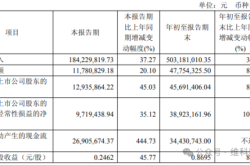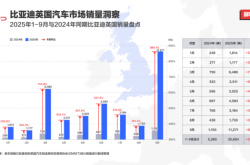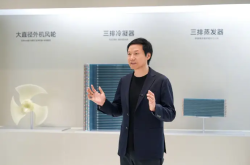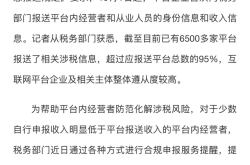Unitree's dominance in the south and the market's search for a northern representative
![]() 03/14 2025
03/14 2025
![]() 622
622

The symbolic significance of Unitree Technology reaching the "throne" cannot be ignored. The demonstration effect of benchmark enterprises drives the industry to iterate towards higher-order goals, but it is also necessary to be vigilant against the potential overshadowing of ecological diversity by "unipolar narratives". The ultimate vision of industrial prosperity is not a zero-sum game where "one dominates all", but rather the coordinated progress of "benchmark leadership" and "competitive growth".
Editor: Di Xintong
The robot industry has long been known as "Li Zexiang in the south and Wang Tianmiao in the north", and this conclusion has also transitioned to the humanoid robot industry. As Unitree Technology "dominates all sides", its benchmark status as "Unitree in the south" has been recognized by the industry. Against this backdrop, the market urgently needs to identify a "northern representative" comparable to Unitree Technology within the northern contingent.
After discussing with multiple insiders in the embodied intelligence industry, the Embodied Learning Society received different opinions. Several humanoid robot enterprises in the north were nominated to compete for the title of "northern representative", but the industry has not yet formed a unified consensus.
And this clearly points out the same viewpoint: Unitree Technology's story is difficult to replicate at this stage.
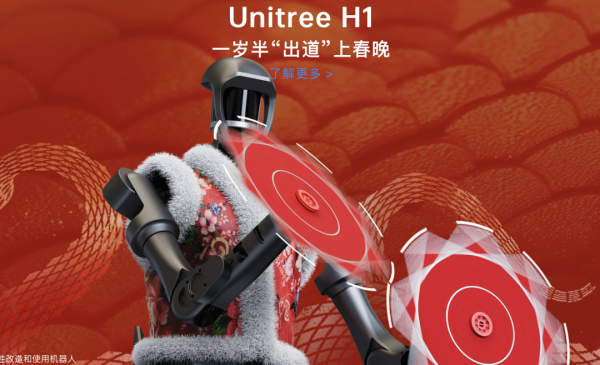
Image source: Unitree Technology
On the one hand, Unitree Technology's current exposure is the result of "favorable timing, advantageous circumstances, and good will". Standing in a benchmark position is both an inevitability of the times and has the connotation of a random, accidental event;
On the other hand, Unitree Technology focuses on "motion control capabilities", and its capabilities are indeed half a step ahead of the industry, even able to compete with overseas players on the international stage. When Unitree Technology becomes a "reference point", "motion control capabilities" naturally become a key yardstick for measuring humanoid robots. However, the current humanoid robot field is in a stage of flourishing, and although "motion control capabilities" cannot compete head-on with Unitree Technology, it does not mean that other manufacturers are "lacking".
This shows that there are indeed players capable of competing with Unitree Technology, but other manufacturers lack a window to be seen.
The symbolic significance of Unitree Technology reaching the "throne" cannot be ignored. The demonstration effect of benchmark enterprises drives the industry to iterate towards higher-order goals, but it is also necessary to be vigilant against the potential overshadowing of ecological diversity by "unipolar narratives". The ultimate vision of industrial prosperity is not a zero-sum game where "one dominates all", but rather the coordinated progress of "benchmark leadership" and "competitive growth".
"Praising one" is certainly not about "stepping on many". After all, the essence of industrial progress lies in the innovative resonance of multiple subjects, rather than symbolic regional label competitions.

The contingency and inevitability of Unitree Technology's explosion in popularity
The simplest and most direct method to judge whether something is truly popular or not is to see if "scalpers" have entered the market.
When someone spends 300,000 yuan to purchase a Unitree Technology G1 for rent, earning 10,000 yuan in daily rent and having orders scheduled for months; when foreign enterprises purchase Unitree Technology robots for secondary development and training, earning hundreds of thousands of yuan in price differences before reselling. This indicates that Unitree Technology has truly "taken off". From being rejected by investors who didn't understand it to becoming a sought-after stock in the capital market, Unitree Technology's popularity has been reflected in multiple dimensions.
Just like there's nothing Lei Jun can't sell, there's also "nothing" Unitree Technology can't promote.
Attributing the current prosperity solely to the "Spring Festival Gala" clearly underestimates Unitree Technology's strength. As one of the first enterprises to develop global quadruped robots, Unitree Technology's nearly 10-year entrepreneurial journey has not only been about its own 0-1 but also the entire industry's 0-1.
In 2016, Unitree Technology was founded. In a narrow garage, apart from Wang Xingxing's personal experience of developing a quadruped robot prototype, the stories unfolding in this garage did not seem very appealing. However, just one year after its establishment, Unitree Technology launched its first consumer-grade quadruped robot, Unitree Laikago. Since then, Unitree Technology's product line has expanded to include industrial and professional-grade products. In 2020, Unitree Technology released Unitree A1, which is now one of the important platforms for global developers to conduct robot research and application development.
What truly opened up Unitree Technology's situation were its industrial-grade wheeled quadruped robot B2-W and humanoid robot products.
B2-W can perform difficult moves such as spinning in place for two weeks and then flipping upside down for three and a half weeks, enabling it to perform various high-risk and difficult tasks. For example, it can conduct inspections and rescues in hazardous environments. Its ability to serve as a "mount" has also opened up new application scenarios, such as transporting materials in complex terrains. As a mobile platform, it can carry sensors and detection equipment to achieve remote control. A wave of show-off videos even prompted Musk to like and share them.
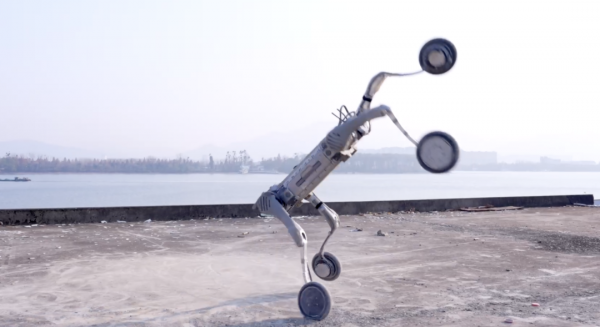
Image source: Unitree Technology
The two humanoid robot products, Unitree H1 and Unitree G1, showcase two evolutionary directions for humanoid robots. Unitree H1 is Unitree Technology's first full-size humanoid robot, setting a new world record for walking speed among humanoid robots; it successfully performed standing backflips without relying on a hydraulic system for the first time. It is more suitable for industrial-grade applications and can be implemented in factories. Wang Xingxing revealed that H1 is already undertaking high-risk material handling tasks in automobile factories.
Unitree G1, on the other hand, is geared towards the consumer or research and education markets, promoting the pace of secondary development and exploration of new technologies by research institutions or universities. This is mainly due to Unitree G1's imitation learning and reinforcement learning capabilities, allowing it to "autonomously" unlock new skills. By choosing an "open-source" design approach, developers can train exclusive AI models based on API interfaces.
The above products have shattered the argument that quadruped robots and humanoid robots can only be regarded as "toys". Through technological breakthroughs, they have enabled quadruped robots and humanoid robots to move out of laboratories and into the physical world, becoming "usable".
Apart from product strength, Unitree Technology's more competitive advantage lies in its extreme cost control, breaking through market bottom prices.
Wang Xingxing once said, "I have a pretty good sense of cost reduction because I've always spent my own pocket money on various things since I was young. In 2010, when I made a bipedal robot, the total cost of mechanical parts was just 200 yuan, so don't compare cost reduction with us; we can continue to reduce it by a lot."
Wang Xingxing's personal experience is also reflected in Unitree Technology. Currently, Unitree Technology's self-research rate exceeds 90%, covering core components such as motors, reducers, controllers, and lidar. In addition, Unitree Technology has also established a dedicated robot component production company, further enhancing in-house production.
Self-research not only grants technological initiative, making differentiated development paths possible, but more importantly, it focuses on cost control in mass production, giving Unitree Technology a proactive advantage on the pricing side. This allows Unitree Technology to be neither constrained by upstream technological development nor to maneuver within a price range.
And this is also one of the primary reasons why the Unitree G1, priced at less than 100,000 yuan, triggered a wave of user purchases and secondary dissemination on social media.
It can be seen that the Spring Festival Gala only ignited the fuse for Unitree Technology's dissemination, with more support coming from Unitree Technology's own strength. However, for the Spring Festival Gala, Unitree Technology may have been just an accidental choice. After all, before this, products from other humanoid robot manufacturers have also appeared on the Spring Festival Gala. Perhaps the technological background at that time was not as mature as it is now, or perhaps the robots did not attract outside attention. In any case, they did not welcome the traffic boom that Unitree Technology is currently experiencing.

The south is not just Unitree
The north is not without representatives either
When Unitree Technology becomes synonymous with the south, the southern humanoid robot team is not just Unitree Technology; there are also a group of "silicon stars" standing beside it.
Whether on social media or in real streets and alleys, various robots in the south are showcasing their own "signature skills". For example, Zhongqing Robotics, known for its gait and the most human-like walking with straight knees, has added the skill of a "front flip" and recently appeared running in Shenzhen Bay; Zhiyuan Robotics, with a thousand units produced, has a new product capable of riding a bicycle; Magic Atom's "Wheat", serving as a report host and preparing for marathons with a tight schedule...
Switching perspectives, although the industry has not yet reached a consensus on the "northern representative", it does not mean that there are no robots in the north that can be pushed to the forefront.
On the motion control capability side, the "Tiangong" from the Beijing Humanoid Robot Innovation Center has evolved its running speed from 6 kilometers per hour to 12 kilometers per hour. Recently, it has achieved the ability to continuously cross multiple stairs without bumping, stepping on edges, or stepping into empty spaces, and can also step onto steps with a large height difference of 35 centimeters. Facing complex terrain, Tiangong can also achieve stable running.
Running on a football field to play football, the accelerated evolution Booster T1 won multiple games with a total of 24 goals at the 2024 RoboCup Robot World Cup, competing against teams from the United States, Germany, South Korea, and others, and won the runner-up in the technology challenge. In addition to playing football and performing the "Ip Man squat", Booster T1's ability to withstand impacts has gradually improved, already capable of withstanding fierce impacts such as "breaking stones on the chest" and "beer bottles hitting the head".
Positioned as "providing general humanoid robot bodies and development platforms for developers such as students and researchers in universities and the scientific research industry", Booster T1 is building an ecosystem of hardware + software + development tools, and its products have been sold overseas.
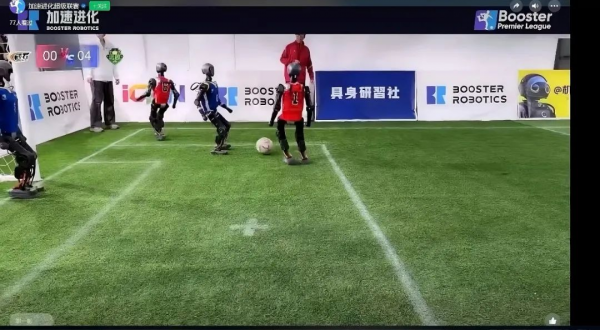
Image source: Accelerated Evolution
On the application capability side, Galaxy Universal's wheeled robot GALBOT G1 has an arm span of 190cm and an operating range from 0 to 240cm. Its foldable design allows it to grab objects on the ground in a "kneeling" position and complete tasks on items over two meters high in a "standing" position. Galbot G1 has been trial-operated in Meituan pharmacies, where it autonomously analyzes restocking requests within the pharmacy scene, recognizes corresponding products from cargo baskets, and precisely grabs and places them in the corresponding positions. The operating range spans from the top to the bottom of the shelves.
There is also Xingdong Jiyuan, which has created ERA-42, an end-to-end native robot large model. Its humanoid robot STAR1 once "retraced the Silk Road", navigating various terrains such as mountains, grasslands, Gobi deserts, and highways. Not long ago, STAR1 mastered the dexterous operation of using chopsticks to pick up dumplings, becoming the first humanoid robot to achieve such a task; Lingbao CASBOT, capable of fine operations and targeting factory scenarios, has already been applied in notebook assembly scenarios. During its recent completion of a new round of financing, it also announced that it has started deliveries and is accelerating mass production plans.
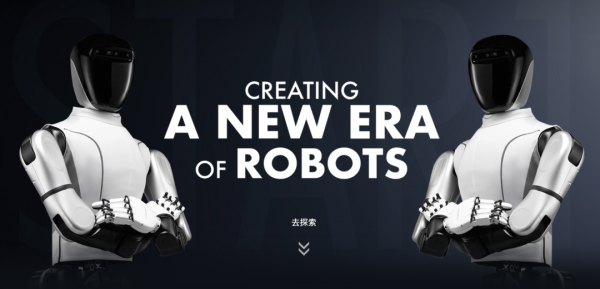
Image source: Xingdong Jiyuan
"There are differences in regions, but no differences in moving forward".
In the vast scroll of China's humanoid robot industry, there are not only Unitree Technology, renowned as "Unitree in the south", but also manufacturers that are silently savings ing their strengths, jointly painting a vast sea of stars for diverse innovation.
The essence of industrial prosperity lies in the coexistence and spread of innovative sparks. The leadership of benchmark enterprises is like the North Star hanging high, guiding the direction; while the ecosystem of competitive growth is the inexhaustible driving force for breaking through the deep waters of technology. The future has arrived, where only the open-minded will progress, only the collaborative will be strong, and only the innovative will prevail. Every explorer on this fertile soil in the East will eventually perform a "time when stars shine" on the global stage.

